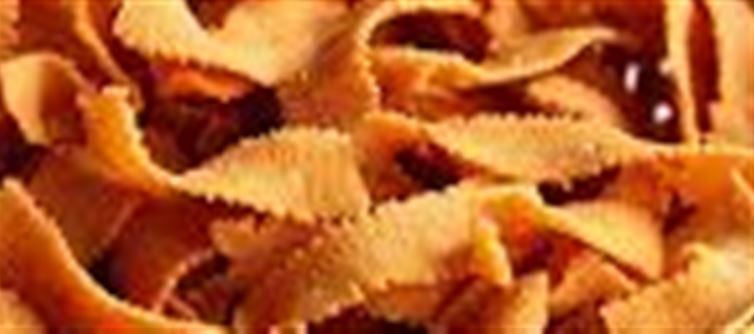
Ribbon Pakoda is a popular South indian snack, famous for its crispy texture and savory flavor. The snack gets its name from its distinctive ribbon-like shape. Made from rice flour, besan (gram flour), and spices, ribbon pakoda is usually served during festivals like diwali or as a tea-time snack. It's crunchy, flavorful, and, when made right, can also provide some health benefits, making it a treat you can enjoy with care.
How to Make Ribbon Pakoda: Easy Recipe
Ingredients:
· 1 cup rice flour
· 1/2 cup besan (gram flour)
· 2 tbsp hot oil (for the dough)
· 1/4 tsp hing (asafoetida)
· 1/2 tsp red chili powder (adjust to taste)
· 1/4 tsp turmeric powder
· 1/4 tsp cumin seeds (optional)
· salt to taste
· 1-2 tbsp sesame seeds (optional)
· Water as needed
· oil for deep frying
Method:
1. Prepare the Dough:
In a large bowl, mix together rice flour, besan, salt, turmeric powder, red chili powder, cumin seeds (optional), and sesame seeds (optional). Add hot oil to the dry ingredients and mix well to form a crumbly mixture. Gradually add water and knead into a smooth, firm dough. The dough should be firm but pliable.
2. Shape the Pakodas:
Transfer the dough into a ribbon pakoda maker (or a regular murukku press with a ribbon-shaped attachment). Heat oil in a deep frying pan over medium heat. Once the oil is hot, press the dough into the hot oil, shaping it into ribbons. Fry until golden brown and crispy, turning occasionally to ensure even frying.
3. Drain and Cool:
Remove the pakodas from the oil and drain on paper towels to remove excess oil. Let them cool completely before serving. Enjoy with a cup of tea!
Health Benefits of Ribbon Pakoda
While ribbon pakoda is typically deep-fried, it still offers some benefits when made with the right ingredients and enjoyed in moderation:
1. Energy Boosting:
The combination of rice flour and besan provides a quick source of energy. Both flours are rich in carbohydrates, offering sustained energy, which can make ribbon pakoda a satisfying snack to fuel your day.
2. Rich in Protein:
Besan (gram flour) is a good source of plant-based protein, which is essential for muscle building, tissue repair, and overall strength. This makes ribbon pakoda a protein-packed alternative to many other fried snacks.
3. Fiber Content:
Rice flour, although lower in fiber compared to whole grains, still contributes to digestive health. The fiber helps in promoting proper digestion and can prevent constipation, aiding gut health when consumed in moderation.
4. Antioxidant Properties:
The addition of turmeric and red chili powder not only enhances the flavor but also provides anti-inflammatory and antioxidant benefits. Turmeric contains curcumin, which is known for its potential to fight inflammation and support immune function.
5. Rich in Healthy Fats:
Sesame seeds, often included in ribbon pakoda, are rich in healthy fats like omega-3 and omega-6 fatty acids, which contribute to heart health. These seeds also contain calcium and iron, supporting bone strength and red blood cell production.
Healthier Alternatives & Tips
While ribbon pakoda can be enjoyed as a tasty treat, here are a few modifications for a healthier version:
1. Air Frying: Instead of deep-frying, consider air-frying your pakodas for a lower-fat version while still retaining the crunch.
2. Reduce salt & Spices: If you're watching your salt intake or prefer milder flavors, adjust the seasoning accordingly.
3. Portion Control: Since ribbon pakoda is a fried snack, enjoy it in moderation, especially if you’re watching your calorie intake.
Conclusion
Ribbon pakoda is a delectable, crispy snack that holds a special place in indian cuisine. While it’s indulgent and typically fried, the key ingredients like besan and sesame seeds provide a host of nutritional benefits. By making a few small adjustments, you can enjoy this savory snack guilt-free, and it can be a healthier option compared to many other fried snacks. Enjoy in moderation and savor the crispy goodness!
Disclaimer:
The views and opinions expressed in this article are those of the author and do not necessarily reflect the official policy or position of any agency, organization, employer, or company. All information provided is for general informational purposes only. While every effort has been made to ensure accuracy, we make no representations or warranties of any kind, express or implied, about the completeness, reliability, or suitability of the information contained herein. Readers are advised to verify facts and seek professional advice where necessary. Any reliance placed on such information is strictly at the reader’s own risk.




 click and follow Indiaherald WhatsApp channel
click and follow Indiaherald WhatsApp channel